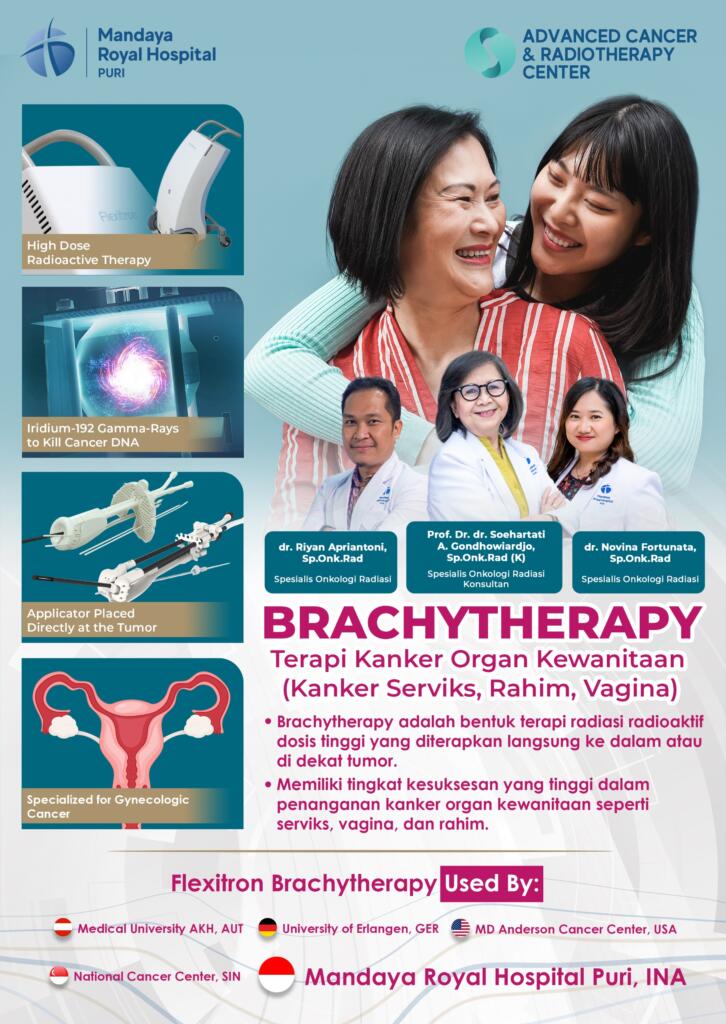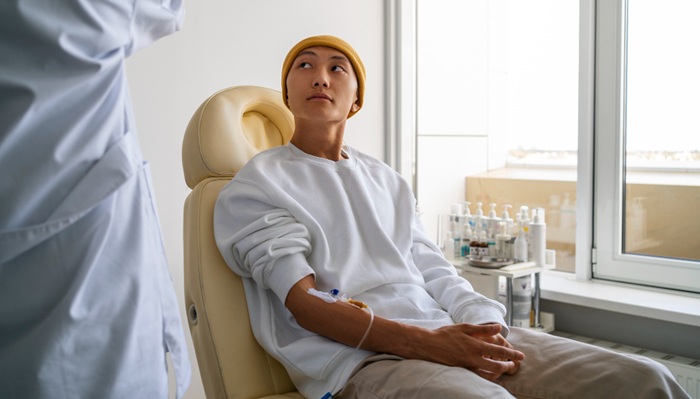Brachytherapy works differently from external beam radiotherapy. It is performed by placing radioactive material inside the body, which is why it is often referred to as internal radiation therapy.
Through brachytherapy, doctors can deliver a higher radiation dose compared to external radiotherapy. Because the radiation is directed precisely to the affected area, the risk of damaging nearby healthy tissues is significantly reduced. Moreover, brachytherapy treatment time is usually shorter, as large doses of radiation can be safely delivered in a single session.
Contents
Placement of Radioactive Material in Brachytherapy
The brachytherapy procedure involves placing radioactive material inside the body, directly near the cancer site.
The method and placement location depend on several factors, including the tumor’s location and spread, the patient’s overall health condition, and the specific treatment goals.
The radioactive material may be placed either inside a body cavity or directly within body tissue:
-
Intracavitary Brachytherapy (Radiation Inside a Body Cavity)
In this method, a device containing radioactive material is placed inside a body cavity—such as the trachea or vagina. These devices are typically shaped like tubes or cylinders, specifically designed to fit the cavity where radiation will be administered.
-
Interstitial Brachytherapy (Radiation Inside Body Tissue)
In this approach, a device containing radioactive material is inserted directly into body tissue, such as in the breast or prostate area. The devices used may include wires, small balloons, needles, or tiny radioactive seeds (the size of a grain of rice) that emit radiation precisely to the cancerous tissue.
How the Brachytherapy Procedure Is Performed
Each patient’s experience with brachytherapy may vary depending on the type of treatment they undergo. The radiation may be administered for a temporary duration or remain permanently in the body.
-
Temporary Brachytherapy
In temporary brachytherapy, the radioactive material remains in the body for only a limited time—ranging from a few minutes to about 20 minutes. Patients may undergo one or two sessions per day over several days, depending on the treatment plan.
During the procedure, the patient will lie in a comfortable position. Depending on the treatment type, the doctor may administer anesthesia. A brachytherapy device—either a tube inserted into a body cavity or a small needle placed directly into the cancer area—will then be positioned.
The radioactive material is inserted into the brachytherapy device using a specialized machine. During radiation delivery, the doctor leaves the room but monitors the patient closely through cameras and an audio system.
Patients may experience mild discomfort during the procedure. If they feel uneasy or anxious, they are encouraged to inform the medical team immediately.
Once the radioactive material is removed, the patient no longer emits radiation and poses no risk to others, allowing them to resume normal activities safely.
-
Permanent Brachytherapy
In some cases, radioactive material is permanently implanted in the body—most commonly for prostate cancer treatment.
The radioactive seeds are placed manually under image guidance, such as ultrasound or CT scan, to ensure accurate positioning. The procedure is performed under anesthesia, so patients do not feel any discomfort.
After the procedure, the body emits low-dose radiation from the treated area. However, the exposure risk to others is extremely low. Patients may be advised to limit close contact with children or pregnant women for a short period. Over time, radiation levels decrease naturally until they are completely safe.
Brachytherapy at Mandaya Royal Hospital Puri Uses Flexitron Technology Equal to World-Class Cancer Centers

Mandaya Royal Hospital Puri offers not only external radiotherapy but also brachytherapy for treating various types of cancer.
The hospital uses the Flexitron Brachytherapy System, an advanced technology also used at world-renowned cancer centers such as MD Anderson Cancer Center (USA), National Cancer Center (Singapore), University of Erlangen (Germany), and Medical University AKH (Austria).
The Flexitron Brachytherapy System is a High Dose Rate (HDR) afterloading system, designed to deliver radiation directly into or near the tumor area with exceptional precision.
This technology enhances safety, efficiency, and accuracy while minimizing radiation exposure to surrounding healthy tissues. With Flexitron, patients receive an optimal radiation dose to destroy cancer cells effectively without harming normal tissues.
Expert Radiation Oncology Team Specializing in Brachytherapy at Mandaya Royal Hospital Puri
Brachytherapy at Mandaya Royal Hospital Puri is performed by a team of highly skilled radiation oncologists with expertise in both brachytherapy and advanced radiotherapy techniques.
1. Prof. Dr. dr. Soehartati A. Gondhowiardjo, Sp.Onk.Rad (K)

Prof. Soehartati is a distinguished radiation oncologist with extensive clinical and academic experience. She completed her medical education at Universitas Indonesia and pursued advanced training in Radiation Oncology at Wilhelm-Westfälischen Universität Münster, Germany.
She holds a Doctorate in Medicine from Universitas Indonesia in collaboration with AKH Vienna, and actively participates in international training programs such as the ESTRO Evidence-Based Radiation Oncology Course (2023) and the Indonesia–IAEA Workshop (2023).
Her experience and dedication have greatly contributed to the advancement of radiation oncology services in Indonesia.
Clinic Hours:
- Wednesday: 13:30 – 17:00 WIB
2. dr. Novina Fortunata, Sp.Onk.Rad

dr. Novina Fortunata earned her medical degree from Universitas Airlangga and specialized in Radiation Oncology at Universitas Indonesia.
She actively keeps up with the latest innovations in radiotherapy by attending scientific forums and training programs such as the Jakarta Annual Collaborative Cancer Meeting (JACCM), FARO Webinar Series, and Continuing Medical Education (CME) sessions by the Indonesian Radiation Oncology Society (IROS).
Her continuous involvement in scientific activities ensures she stays at the forefront of modern radiation-based cancer treatments.
Clinic Hours:
- Monday – Friday: 08:00 – 16:00 WIB
- Saturday: 08:00 – 13:00 WIB
3. dr. Riyan Apriantoni, Sp.Onk.Rad

dr. Riyan Apriantoni graduated from Universitas Sriwijaya and completed his specialization in Radiation Oncology at Universitas Indonesia.
He is proficient in modern radiotherapy techniques such as Stereotactic Radiosurgery (SRS) and Stereotactic Body Radiation Therapy (SBRT), which allow high-dose radiation delivery with exceptional precision.
Additionally, dr. Riyan is experienced in performing brachytherapy and other radiation-based treatments, customizing each approach based on the patient’s condition for the best possible outcomes.
Clinic Hours:
- Monday – Friday: 17:00 – 19:30 WIB
To make your visit to Mandaya Royal Hospital Puri easier, you can use the Chat via WhatsApp, Book Appointment, or Care Dokter App, available on Google Play and App Store—allowing you to schedule visits, check queue numbers, and access complete hospital information conveniently.



